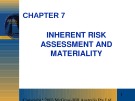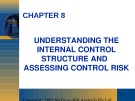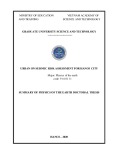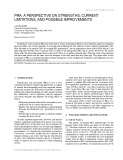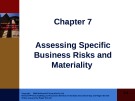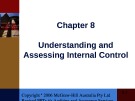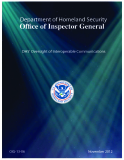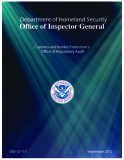
Inherent risk assessment
-
This research paper endeavors to assess the safety risks inherent in tower crane operations at construction sites in Vietnam. This assessment is conducted from the perspective of various stakeholders involved in tower crane activities, namely managers, operators, and workers.
 13p
13p  viohoyo
viohoyo
 25-04-2024
25-04-2024
 4
4
 2
2
 Download
Download
-
Chapter 7 - Inherent risk assessment and materiality. After studying this chapter you should be able to: explain the factors that influence the assessment of inherent risk; explain the auditor’s consideration of the special risk areas of fraud, related parties and the appropriateness of the going concern basis; and explain the concept of materiality.
 23p
23p  tradaviahe19
tradaviahe19
 29-03-2021
29-03-2021
 14
14
 2
2
 Download
Download
-
Chapter 8 - Understanding the internal control structure and assessing control risk. After studying this chapter you should be able to: Define internal control, and explain the audit logic of assessing control risk; understand the concepts of inherent limitations and reasonable assurance with regard to internal control; describe the general objectives of internal control and how the auditor uses them to develop specific control objectives;...
 49p
49p  tradaviahe19
tradaviahe19
 29-03-2021
29-03-2021
 11
11
 3
3
 Download
Download
-
Upgradation and enhancement of the urban seismic risk assessment tool in Vietnam based on the inherent results of the previous studies and the cutting-edge methodology of seismic risk assessment in the world; development of a realistic portrayal of seismic risk for the Hanoi urban area based on the state-of-the-art methodologies for seismic risk assessment and updated dataset.
 29p
29p  capheviahe27
capheviahe27
 23-02-2021
23-02-2021
 18
18
 3
3
 Download
Download
-
Chapter 7 - Assessing specific business risks and materiality. In this chapter we will discuss: explain why the decision to accept a client is important, and describe the primary features of client acceptance and continuance; indicate the purpose and content of an audit engagement letter; describe the decisions made by an auditor in preparing an audit plan, the knowledge on which the decisions are based and the procedures used to obtain that knowledge.
 39p
39p  thuongdanguyetan04
thuongdanguyetan04
 18-04-2020
18-04-2020
 16
16
 1
1
 Download
Download
-
Chapter 8 - Understanding and assessing internal control. In this chapter we will discuss: explain the factors that influence the assessment of inherent risk; explain the auditor’s consideration of the special risk areas of fraud, related parties and the appropriateness of the going concern basis; and explain the concept of materiality.
 61p
61p  thuongdanguyetan04
thuongdanguyetan04
 18-04-2020
18-04-2020
 13
13
 1
1
 Download
Download
-
Probabilistic risk assessment (PRA) has been used in various technological fields to assist regulatory agencies, managerial decision makers, and systems designers in assessing and mitigating the risks inherent in these complex arrangements. Has PRA delivered on its promise? How do we gage PRA performance? Are our expectations about value of PRA realistic? Are there disparities between what we get and what we think we are getting form PRA and its various derivatives?
 10p
10p  minhxaminhyeu5
minhxaminhyeu5
 30-06-2019
30-06-2019
 17
17
 1
1
 Download
Download
-
In this chapter, students will be able to understand: explain the factors that influence the assessment of inherent risk; explain the auditor’s consideration of the special risk areas of fraud, related parties and the appropriateness of the going concern basis; and explain the concept of materiality.
 31p
31p  shiwo_ding2
shiwo_ding2
 03-04-2019
03-04-2019
 19
19
 2
2
 Download
Download
-
In this chapter, students will be able to understand: Define internal control, and explain the audit logic of assessing control risk; understand the concepts of inherent limitations and reasonable assurance with regard to internal control; describe the general objectives of internal control and how the auditor uses them to develop specific control objectives.
 62p
62p  shiwo_ding2
shiwo_ding2
 03-04-2019
03-04-2019
 28
28
 1
1
 Download
Download
-
Chapter 6 - Planning the audit; linking audit procedures to risk. This chapter explained the manner in which auditors plan an audit and design audit programs. In this chapter, the learning objectives are: Identify the factors considered by auditors in accepting new clients, explain a CPA's responsibilities when planning an audit, explain how the auditors assess a client's business risk and use these risks to determine inherent risks.
 21p
21p  nomoney2
nomoney2
 10-02-2017
10-02-2017
 49
49
 3
3
 Download
Download
-
Community management of patients with organic brain damage can be difficult. They often do not attend appointments. The community nursing team may be able to offer advice and support to the patient. A community care assessment by the social work department may be needed. If drinking continues to be problematic, sometimes patients will agree to an arrangement with their family or their social worker such that, at any one time, they only have access to small amounts of their money.
 74p
74p  seketnoi
seketnoi
 26-04-2013
26-04-2013
 41
41
 2
2
 Download
Download
-
In the first year of an internal audit start-up, companies typically do not have a formal baseline from which to evaluate the effectiveness of control activities. As such, the initial risk assessment and audit plan are developed primarily at inherent risk level. Inherent risks are those present in the normal course of conducting business activities. These include external risks such as changes to global, national and economic climates, as well as technological, legal and political changes.
 18p
18p  doipassword
doipassword
 01-02-2013
01-02-2013
 55
55
 4
4
 Download
Download
-
With a solid understanding of the company, its objectives and inherent risks, the auditor must consider the possible impact of the various risks on the achievement of business objectives and the likelihood of their occurrence. By considering both the impact of key risks and the likelihood of occurrence, a risk profile of the organisation can be developed. The risk profile is presented to management and the audit committee using a colour-coded heat map that identifies high, moderate and low risk areas.
 28p
28p  doipassword
doipassword
 01-02-2013
01-02-2013
 52
52
 4
4
 Download
Download
-
It is critical for internal audit to develop a systematic means to analyse risk. Risk is any event that could prevent the company from achieving its business objectives. A risk assessment allows the auditor to consider how potential events might affect the achievement of business objectives. The risk assessment process begins by defining the audit universe. The audit universe includes all of the business units, processes and operations. Next, the auditor must understand the company’s business model within the context of its industry and its key business objectives.
 10p
10p  doipassword
doipassword
 01-02-2013
01-02-2013
 46
46
 2
2
 Download
Download
-
Bond investors should carefully consider risks such as interest rate, credit, repurchase and reverse repurchase transaction risks. Greater risk, such as increased volatility, limited liquidity, prepayment, non-payment and increased default risk, is inherent in portfolios that invest in high yield ("junk") bonds or mortgage backed securities, especially mortgage backed securities with exposure to sub-prime mortgages.
 19p
19p  taisaocothedung
taisaocothedung
 09-01-2013
09-01-2013
 55
55
 3
3
 Download
Download
CHỦ ĐỀ BẠN MUỐN TÌM









